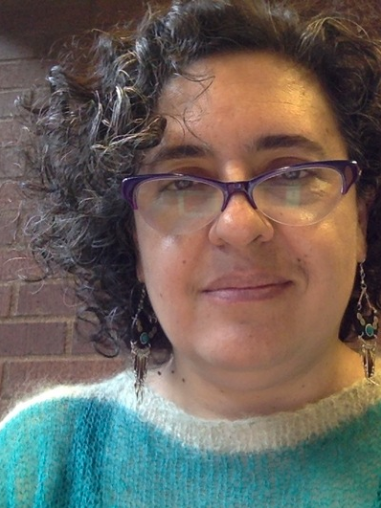Guisela Latorre is Professor of Women’s, Gender, and Sexuality Studies at The Ohio State University. She specializes in modern and contemporary U.S. Latinx and Latin American art with a special emphasis on Chicana/Latina feminism. She has explored these topics in articles, chapters, and two books: Democracy on the Wall: Street Art of the Post-Dictatorship Era in Chile (2019) and Walls of Empowerment: Chicana/o Indigenist Murals from California (2008). In addition, she co-curated and co-authored the exhibition/book ¡Murales Rebeldes! L.A. Chicana/Chicano Murals Under Siege (2017).

Latorre became involved with Frontiers when the Journal moved from Arizona State University to The Ohio State University in 2012. Latorre knew of Frontiers’ importance to the field of women’s, gender, and sexuality studies so when she saw the announcement about finding a new institution for the Journal, she decided to apply. After securing the support systems necessary for running a journal through OSU, Latorre and her colleague Dr. Judy Wu successfully petitioned to house the Journal in their department. The two then served as co-editors until 2017, when they transitioned the Journal to its current location at the University of Utah.
Latorre and Wu focused their time as co-editors on continuing the Journal’s emphasis on women of color feminists and scholarship on the intersections of gender, race, and sexuality. Additionally, Latorre strove to maintain the feminist ethos of the Journal through her editing work as well as through organizing special events such as the Transnational Feminist Summer Institute, and they participated in other activities such as publishing panels at NWSA. These events and activities were “almost like extending the role of the Journal” (Latorre, p. 5) in how they provided resources and mentorship to other scholars.
In her interview, Latorre echoes Wu in her concern with using the Journal to expand what counts as academic work and academic scholarship. Another way they did this was by incorporating pieces written by activists and featuring them in a special section in the issues. Here, people who were involved in social movements or who “had important thoughts regarding gender inequality and racism” (Latorre, 10) had a space to write in the Journal without the limitations of academic language. By publishing these pieces in Frontiers, they were also able to include community voices.
Latorre’s scholarly background in art and art history impacted her work at the Journal. She pursued changes to cover design by asking the University of Nebraska Press to allow an image to take up the whole cover, which made it more of a significant piece of visual art. She pushed for the Journal to publish more art within the issues to create more opportunities for artists to reproduce their work in the Journal. She recruited feminist artists to submit their art and develop their artist statements.
The goal of these efforts was to make the Journal a kind of artist space, especially for artists of color. A proud moment for her was getting an artist from her research on Chilean street art to create the cover art for the special issue on technology and feminism: “Digitizing the Revolution” in 2018. This image, a collage made with paper, not only featured a woman of color but also provided a woman of color graffiti artist to gain exposure and recognition.
Find more about Professor Latorre here.
Selected Quotes from Frontiers at 50 Oral History Interview
“We were cognizant that women of color scholars, who are doing work about women of color or about the intersection of gender, race, sexuality, and all those things, that those spaces were still limited. And so we thought that, you know, we could make the Journal into one more space where somebody who’s doing this kind of research could say, you know, what, about, you know, I think Frontiers might be a good fit for me.” (p. 7)
“We didn’t get around to actually connecting with community or doing events with community that were related to the Journal. It was more about creating a space within the Journal where people who are not writing in an academic vein but who were active in important social movements, or had important thoughts regarding gender inequality, racism, that those folks had a space also in the Journal to write.” (p. 10-11)
“I think the coolest thing is that when you’re reading manuscripts submitted for publication, it is like ‘reading the future of the field’ and that’s really exciting. You get an insight into where the field is going. So, because we got a lot of submissions from grad students, we published a lot of that work. We got submissions from people from other parts of the world. And we also, as I said, before, we also had creative writing submissions, which we’re very cool to read, and also really great to publish, to have Frontiers be a space for creative writing as well.” (p. 14)
“I felt so happy and proud to see a Chilean artist who wasn’t really considered in Chile to be a great artist –but here she is on the cover of Frontiers. Also there was also another Chilean artist that we put on the cover of a special issue on reproductive rights, who was also a graffiti artist. These were artists that I was meeting because in the process of being in Frontiers, in the process of being a co-editor, I was also working on my book on Chilean street art and in that process, I was meeting a number of artists. I felt really proud that we could feature their work on the cover of Frontiers. And so that was also like a particularly proud moment for me.” (p. 16)
The full oral history interview video and transcript can be found the following Frontiers archives locations:
UC Berkeley, Bancroft Library:
University of Utah, J. Willard Marriott Library:
ACCN3283 Frontiers A Journal of Women Studies Oral History Collection
